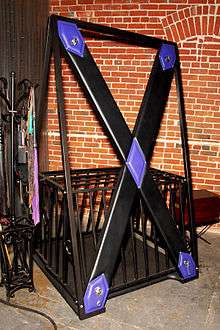Saint Andrew's Cross (BDSM)
The St. Andrew's Cross, crux decussata, X-cross, X-frame or saltire cross is a common piece of equipment in BDSM dungeons. It typically provides restraining points for ankles, wrists, and waist. When secured to a saltire, the subject is restrained in a spreadeagle position.


The St. Andrew's Cross and the spanking bench are the most common pieces of BDSM furniture. Saltires are versatile and easy to manufacture. They are usually firmly attached to a wall, and is distinguished from a BDSM-style Catherine Wheel, which has a central hinge and allows occupants to be turned upside down.
The submissive may be attached to the cross with either the back or front facing the cross. Being restrained facing the cross is the position often used for whipping. Being attached with one's back to the cross is usually more of a sexual bondage position or used for sexual teasing.
The Cross may be purchased from BDSM companies, but many users make their own. Freestanding saltires have a frame which supports the cross. Some homemade freestanding crosses have a tendency to be unstable; a writhing subject can sometimes tip them over, so great caution needs to be exercised in their use. Some freestanding crosses include footrests that greatly improve safety and stability.
The name comes from the crux decussata (diagonal cross) that Saint Andrew is said to have been martyred on.
Literature
- Jay Wiseman: SM 101: A Realistic Introduction. Greenery Press (CA) 1998, ISBN 0-9639763-8-9
- Philip Miller, Molly Devon: Screw the Roses, Send Me the Thorns: The Romance and Sexual Sorcery of Sadomasochism, Mystic Rose Books, 1995. ISBN 0-9645960-0-8.
- Dossie Easton, Janet W. Hardy: The New Topping Book. Greenery Press (CA) 2002, ISBN 1-890159-36-0
| Wikimedia Commons has media related to Saint Andrew's crosses (BDSM). |